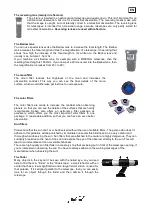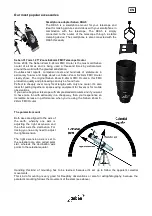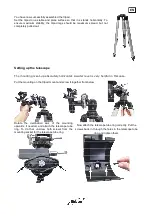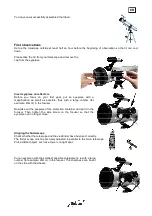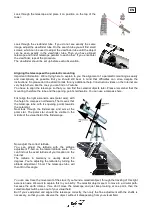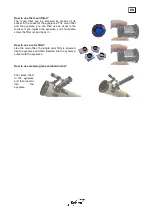
EN
Look through the telescope and place it on position on the top of the
tower.
Look through the viewfinder tube. If you do not see exactly the same
image, adjust the viewfinder tube. On the search tube you will find small
screws, which can be used to adjust the viewfinder tube until the object
can be seen exactly in the viewfinder tube. Then you have aligned
telescope and finder telescope parallel to each other. If you encounter
the viewfinder, repeat the procedure.
The viewfinder should be set up before each observation.
Aligning the telescope with a paralactic mounting
Important information: We’re trying here to explain to you the alignment of a paralactic mounting as easily
and descriptively as possible. But you should still bear in mind that difficulties can arise, despite the
instructions. So please don’t be afraid to look for any additional help. Construction videos on the Internet are
very helpful here, like the ones you can find on Youtube.
You have to align the telescope so that you can find the celestial objects later. Please remember that the
mounting, therefore the tube and the opening, points northwards. You can use a compass here.
First align the right ascension axis (polar axis), with
the help of a compass, northwards. That means that
the telescope tube, with it’s opening, points towards
the polar star.
Now look through the finderscope and aim at the
polar star. The polar star should be visible in the
middle of the visual field of the finderscope.
Now adjust the correct latitude.
You can adjust the latitude with the altitude
adjustment T-bolt on the lateral latitude scale. You
can find out the exact latitude of your location on the
Internet.
The latitude in Germany is usually about 50
degrees. You’re adjusting the latitude by turning the
altitude adjustment T-bolt. The telescope tube will
then tilt in this angle.
You can now trace the movement of the stars, if you found a celestial object, through the tracking of this right
ascension axis. We want to explain this to you briefly: The celestial objects seem to move in a circular path,
because the earth rotates. If we don’t move the telescope and just keep looking at one point, then the
celestial object will be soon out of your visual field.
But if you’ve adjusted and aligned the telescope correctly, then only the fine adjustment with the shafts is
necessary, so that you can observe the object, without it disappearing from your visual field.




